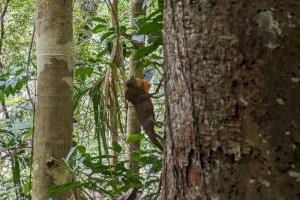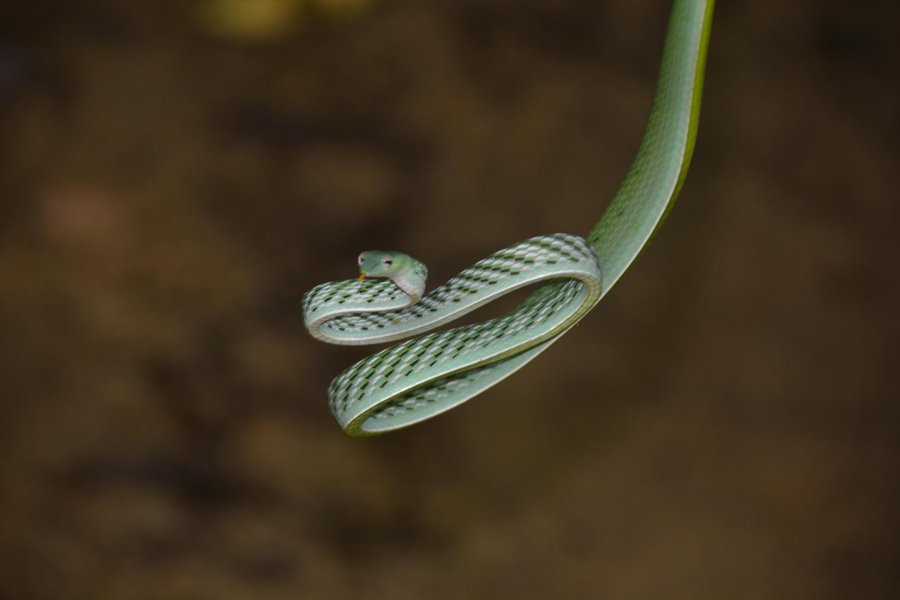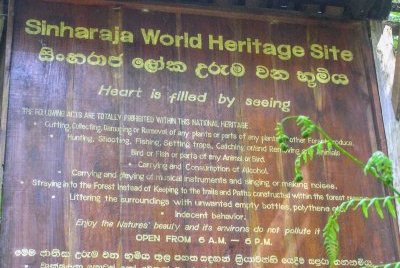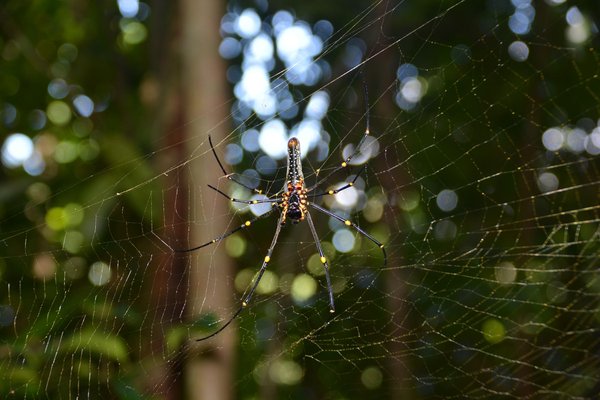Sri Lanka
Sinharaja Forest
The Sinharaja Forest Reserve is a hilly virgin rainforest that is a treasure trove of endemic species, including trees, insects, amphibians, reptiles, birds and mammals.
The flora is a relic of Gondwanaland and thus provides input for the scientific study of continental drift and biological evolution. It also is in a geological transition zone. Notable fauna includes the leopard and Indian elephant, plus the endemic Purple-faced Langur and 95% of Sri Lanka’s endemic birds.
Community Perspective: Animals are hard to see in this dense rainforest. You can access the park from several entrance points; the northern one (Kudawa) seems to be better for bird observation. Reviewers have warned of the leeches. It also is compulsory to pick up a guide from the entrance.
Site Info
Official Information
- Full Name
- Sinharaja Forest Reserve (ID: 405)
- Country
- Sri Lanka
- Status
-
Inscribed 1988
Site history
History of Sinharaja Forest
- 1988: Inscribed
- Inscribed
- 1987: Deferred
- Sri Lanka to pass better protection legislation
- 1982: Deferred
- At Bureau - Needs better protection
- Type
- Natural
- Criteria
- ix
- x
Links
- UNESCO
- whc.unesco.org
- Official
-
- srilanka.travel — Sri Lanka Travel
- Related
-
- environmentlanka.com — Link
- en.wikipedia.org — Link
- sinharajaforestreserve.com — Sinharaja Forest Reserve
All Links
UNESCO.org
- whc.unesco.org — whc.unesco.org/
Official Website
- srilanka.travel — Sri Lanka Travel
Related Resources
- environmentlanka.com — Link
- en.wikipedia.org — Link
- sinharajaforestreserve.com — Sinharaja Forest Reserve
News Article
- April 9, 2021 indepthnews.net — The Destruction of the World Heritage Sinharaja Forest
- Sept. 16, 2011 bbc.co.uk — Sri Lanka suspends road work near Sinharaja forest
- Sept. 11, 2011 colombopage.com — A new species of white monkeys has been found in Sinharaja rain forest
- Aug. 1, 2011 sundaytimes.lk — Sinharaja under "road-threat"
Community Information
- Community Category
- Natural landscape: Forest
Travel Information
Guided Tour Only
Recent Connections
-
Golden jackal
Sri Lankan jackal (subspecies) is liste…
-
Centres of Plant Diversity
IS13 Sinharaja - "Endemism within the p… -
Guided Tour Only
"It is compulsory to obtain a permit is…
Connections of Sinharaja Forest
- Ecology
-
-
Endemic Bird Species
Sri Lanka has c29 endemic birds - around 20 are in Sinharaja -
Rainforests
-
Elephants
Asian Elephant (Sri Lankan Elephant): possibly one or two (see link)See sundaytimes.lk
-
Otters
Eurasian otter -
Strepsirrhini
slow loris -
Golden jackal
Sri Lankan jackal (subspecies) is listed as present in this Mammal List.
-
- Damaged
-
-
Poaching
poaching continues to be of concern
-
- World Heritage Process
-
-
Inscribed at third attempt or more
Def 1982, Def 1987, Ins 1988
-
- Religion and Belief
-
-
Legends and Folk Myths
Means 'Lion-King' and refers to a legendary lion who lives in the forest
-
- WHS on Other Lists
-
-
Centres of Plant Diversity
IS13 Sinharaja - "Endemism within the property is extremely high. Protecting the last viable remnant of Sri Lanka’s tropical lowland rainforest, Sinharaja is home to at least 139 endemic plant species" -
World Biosphere Reserves
Sinharaja (1978) -
World Heritage Forest Programme
-
Biodiversity hotspot
Sri Lanka / Western Ghats -
WWF Global 200
Terrestrial, Tropical and Subtropical Moist Broadleaf Forests: (21) Sri Lankan Moist ForestsSee web.archive.org
-
- Timeline
-
-
Miocene
Ecological separation from India in the late Miocene. The OUV emphasises the endemism arising from this.See www.oneearth.org
-
- Visiting conditions
-
-
Foreigner prices
15 USD, locals possibly 30 rs. (25 cents) -
Guided Tour Only
"It is compulsory to obtain a permit issued by the Department of Forest Conservation and the assistance of an authorized guide to enter to this reserve."
-
News
- indepthnews.net 04/09/2021
- The Destruction of the World Herit…
- bbc.co.uk 09/16/2011
- Sri Lanka suspends road work near …
- colombopage.com 09/11/2011
- A new species of white monkeys has…
Recent Visitors
Visitors of Sinharaja Forest
- Afshin Iranpour
- Alexander Lehmann
- alicemears
- Ali Zingstra
- arina_soboleva
- Aspasia
- Atila Ege
- BaziFettehenne
- Bernard Joseph Esposo Guerrero
- Bin
- c82wc1
- Christravelblog
- Dagmara
- Dimitar Krastev
- Erik Jelinek
- Errol Neo
- Frederik Dawson
- Geert Luiken
- George Gdanski
- GerhardM
- Harald T.
- Hdwilsonau
- Iain Jackson
- Ivan Rucek
- Jacob Otten
- Jana and Matt
- Jarek Pokrzywnicki
- Jeanne OGrady
- Joel on the Road
- Joyce van Soest
- Karito Vies
- Knut
- Kristin
- lichia
- Loic Pedras
- Luis Filipe Gaspar
- Lukasz Palczewski
- marcel staron
- Marlies van Wolfswinkel
- Martin
- Martina Rúčková
- Michael Ayers
- Mikko
- MMM
- Monica Tasciotti
- nan
- Nicolas
- Nihal Ege
- palka25
- Patrik
- Philipp Peterer
- Randi Thomsen
- Reza
- Rob Wilson
- Roger Ourset
- Roman Bruehwiler
- Sandra!
- Sergio Arjona
- Shandos Cleaver
- Shijie ZHU
- Shombob
- Solivagant
- Stanislaw Warwas
- Sturuss
- Svein Elias
- Szucs Tamas
- Taotao Chen
- Tarquinio_Superbo
- Thomas van der Walt
- Tinamu
- tony0001
- triath
- Twobaconsandaboston
- voyager
- Wojciech Fedoruk
- Zach
- Zoë Sheng
- Zos M
- Zsuzsanna Forray
Community Reviews
Show full reviews
When showing my Sri Lanka pictures to friends & family, Sinharaja tends to impress the most, especially for kids. While we didn't venture too deep into the jungle, we still saw plenty of amazing wildlife. A chameleon, flesh eating fish, a poisonous snake, a centipede, ... Sinharaja, even on its outskirts, is full of life.
We entered from the South (Lankagama) and hiked up a set of cascades. After a few meters, the trail turned pretty rough. We were happy to have a ranger accompany us to show us the wildlife and help with the hike.
There is a price to pay though: leeches. It was my first encounter, and I did not know what to expect. I assumed thick socks would shield me. They don't. These suckers are surprisingly competent at getting under multiple layers of clothing for a snack. They also felt like going for a road trip as I removed two of them after we were already back in the car.
Seeing it's been more than 10 years since the last review was written, some comments on past reviews:
-
Betty: The ticket booth at Lankagama was staffed. We had no issues paying and getting a ranger. Personally, I don't think it makes sense to enter the jungle without a ranger to guide you. Skipping the ticket booth is rarely popular with locals, so maybe wait next time.
-
Allison: You must have entered at the other Southern entry. In …

We arrived via two local buses and a tuk tuk from Deniyaya where we stayed at the comfortable but negotiably priced (we were quoted muchly on-line compared to non bookers)Rainforest Lodge. Local buses are around 60rps and tuk tuk was 400 but we still had a 2km walk on rutted muddy tracks to get to the ticket office which was unmanned. The entry fee was supposed to be 550rps each. We thought to pay at the information centre but 200m along the riverside track, we were held up literally by two hostile fellows abusing us for no paying and demanding we return to the ticket office which was now occupied by a self-righteous woman saying she just stepped out to the toilet and we should have waited. The guide from the Rest House near our accomodation back in Deniyaya threatened us with police action for breaking the law by entering a park without paying. We glady offered to pay and attempted a self-defence of no-one there to take our money but the abuse continued and they insisted we return and pay also for a guide for 1100rps additional to the 1100rps entry fee for two. We did not want the guide who spoke not a word of English nor did we feel the track to the information office was so hard to navigate we needed someone to take us there. We had no intention of going deeper into the forest to the waterfall. I had researched the park and there …
Keep reading 0 comments
Sinharaja Rain Forest is possible to visit as a daytrip from Galle. We rented a motor bike for 8 USD. Alternatively you can get a car with driver for around 80 USD. Each way took about 3h (access via Deniaya). The road until Deniaya is good, but traffic in Sri Lanka is a challenge (Buses, Tuktuks, etc.). The road to the entrance is a real adventure, due to bad condition. But with a motor bike you can drive to the entrance and avoid the 2km walk. The forest itself is pleasant, but don't expect to see too many animals (in fact I think I saw more animals along the streets and in the cities) but at least some lizards, snakes and the occasional monkey should be possible. I am sure the inscription is justified, but as visitor I cannot distinguish the difference between Sinharaja and other rainforests (Mexico, Malaysia) I visited, that aren't on the list.
Keep reading 0 comments
I thoroughly enjoyed my visit to Singharaja. We were lucky enough to be guided by Pal of the Singharaja Rest House. He turned out to be an excellent and highly knowledgeable guide that helped us get the most out of our visit.
Keep reading 0 comments
There is a category of WHS which, whilst being “important” in terms of the criteria leading to inscription, doesn’t actually “repay” a great deal to those who go to see them and I have to place Sinharaja in that group.
At the best of times tropical “rain forests” require time and knowledge if they are to be fully appreciated. Insofar as they contain animals and birds these are usually rather difficult to see – the birds either creep around in the undergrowth or flutter in the canopy giving the observer a cricked neck! Such forests are located where the climate is hot and humid. Often the fact that they have survived is a result of their being sited precipitously or remotely. They are not “comfortable” places to visit! I have been “lucky” enough to visit such forests in the Americas, Africa and Asia. Unfortunately for me Sinharaja added little to the experiences already gained and did not really repay the time and effort even though I have no doubt about its significance in terms of being a threatened and unique ecosystem.
If you are in Sri Lanka and have not previously visited such a forest then it could be “worth a visit” but the logistics of getting there are not really suited for a “quick visit”! It will probably take you at least an overnight and a morning even to get inside it. Most people prepared to overcome the difficulties are likely to have more specific Flora/Fauna requirements …
Keep reading 0 comments
I visited Sinharaja in April 2005, the rainy season had just started and as expected, we experienced a fair amount of leeches. We approached Sinharaja from the Ratnapura end, I think there are several areas where one can enter, and this was the region closest to us from where we were staying in Avissawella.
It took around an hour and a half to get there by road on a holiday, just one day before the Sinhala / Tamil New Year. I'm not sure how long it will take to reach there with traffic on a normal day. We arrived there around 8:30am after leaving our base in Gettahetha, Avissawella at around 7am.
All of us were Sri Lankans and the rate we have to pay to enter was lower than what a foreigner would have to pay. We paid for our tickets and picked up our guide and headed towards the entrance in our hired vehicle. The road leading up to the entrance was rather bad and it took a bit of time to get there as we had to travel at a slow pace avoiding all the potholes.
Upon entering Sinharaja, we hiked about 1 and a half kilometers and climbed about 350 meters to reach a mountain summit from where we could see all the surrounding hills and valleys, it was really a remarkable sight. I took my video camera along and recorded every aspect of our journey. It took us around 2 hours to get there and …
Keep reading 0 comments
